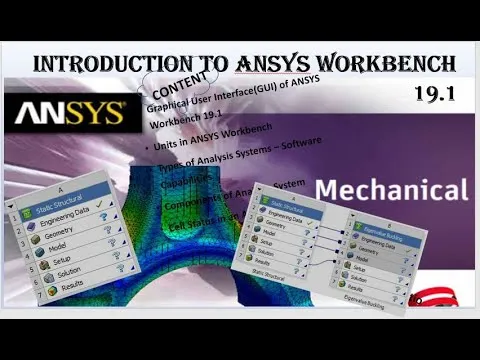
ANSYS Workbench Tutorial Video Lessons & Training for Beginners and Professionals 
This channel provides ANSYS Workbench tutorial videos and training for both beginners and professionals in the field of mechanical engineering. It is designed to help students and designers gain a better understanding of the software. ▼
ADVERTISEMENT
Course Feature
![]() Cost:
Cost:
Free
![]() Provider:
Provider:
Youtube
![]() Certificate:
Certificate:
No Information
![]() Language:
Language:
English
![]() Start Date:
Start Date:
Self Paced
Course Overview
❗The content presented here is sourced directly from Youtube platform. For comprehensive course details, including enrollment information, simply click on the 'Go to class' link on our website.
Updated in [March 06th, 2023]
This course provides an overview of ANSYS Workbench, a powerful engineering simulation platform. It is designed for both beginners and professionals who want to learn how to use the software to create and analyze simulations. The course covers topics such as creating a project, setting up a simulation, running the simulation, and post-processing the results. It also includes tutorials on how to use the various tools available in ANSYS Workbench. By the end of the course, participants will have a better understanding of the capabilities of ANSYS Workbench and be able to use it to create and analyze simulations.
[Applications]
After completing this course, users are encouraged to apply their newfound knowledge to their own projects. They can use the ANSYS Workbench to create simulations and analyze results, as well as to create and modify geometry. Additionally, users can use the ANSYS Workbench to create and modify materials, as well as to create and modify mesh. Finally, users can use the ANSYS Workbench to create and modify boundary conditions and to run simulations.
[Career Paths]
1. Mechanical Engineer: Mechanical engineers use ANSYS Workbench to design and analyze mechanical systems, such as engines, machines, and tools. They use the software to create 3D models, simulate the performance of the system, and optimize the design. With the increasing demand for more efficient and reliable mechanical systems, the demand for mechanical engineers with ANSYS Workbench experience is expected to grow.
2. Aerospace Engineer: Aerospace engineers use ANSYS Workbench to design and analyze aircraft and spacecraft. They use the software to create 3D models, simulate the performance of the system, and optimize the design. With the increasing demand for more efficient and reliable aircraft and spacecraft, the demand for aerospace engineers with ANSYS Workbench experience is expected to grow.
3. Automotive Engineer: Automotive engineers use ANSYS Workbench to design and analyze automotive systems, such as engines, transmissions, and brakes. They use the software to create 3D models, simulate the performance of the system, and optimize the design. With the increasing demand for more efficient and reliable automotive systems, the demand for automotive engineers with ANSYS Workbench experience is expected to grow.
4. Civil Engineer: Civil engineers use ANSYS Workbench to design and analyze civil engineering projects, such as bridges, dams, and buildings. They use the software to create 3D models, simulate the performance of the system, and optimize the design. With the increasing demand for more efficient and reliable civil engineering projects, the demand for civil engineers with ANSYS Workbench experience is expected to grow.
[Education Paths]
1. Mechanical Engineering: Mechanical engineering is a broad field that involves the design, development, and production of machines and tools. It is one of the oldest and most versatile engineering disciplines, and its graduates are in high demand in many industries. Mechanical engineering is a rapidly evolving field, with new technologies and materials being developed all the time. This degree path is ideal for those interested in designing and building machines, as well as those interested in the development of new technologies.
2. Computer Science: Computer science is a rapidly growing field that involves the study of computers and their applications. It is a highly versatile degree path, with graduates finding employment in a variety of industries, from software development to robotics. Computer science is a rapidly evolving field, with new technologies and applications being developed all the time. This degree path is ideal for those interested in developing software, designing computer systems, and creating new technologies.
3. Aerospace Engineering: Aerospace engineering is a field that involves the design, development, and production of aircraft and spacecraft. It is a highly specialized field, and its graduates are in high demand in the aerospace industry. Aerospace engineering is a rapidly evolving field, with new technologies and materials being developed all the time. This degree path is ideal for those interested in designing and building aircraft and spacecraft, as well as those interested in the development of new technologies.
4. Robotics Engineering: Robotics engineering is a field that involves the design, development, and production of robots and robotic systems. It is a rapidly growing field, and its graduates are in high demand in many industries. Robotics engineering is a rapidly evolving field, with new technologies and materials being developed all the time. This degree path is ideal for those interested in designing and building robots, as well as those interested in the development of new technologies.
Course Provider

Provider Youtube's Stats at AZClass
Discussion and Reviews
0.0 (Based on 0 reviews)
Explore Similar Online Courses

Ethical Hacking - A Hands-On Approach to Ethical Hacking

Building a Cloud-Based iOS Application With Parse Framework

Python for Informatics: Exploring Information

Social Network Analysis

Introduction to Systematic Review and Meta-Analysis

The Analytics Edge

DCO042 - Python For Informatics

Causal Diagrams: Draw Your Assumptions Before Your Conclusions

Whole genome sequencing of bacterial genomes - tools and applications

Ansys Tutorial

CFD Post Training Course


Start your review of ANSYS Workbench Tutorial Video Lessons & Training for Beginners and Professionals